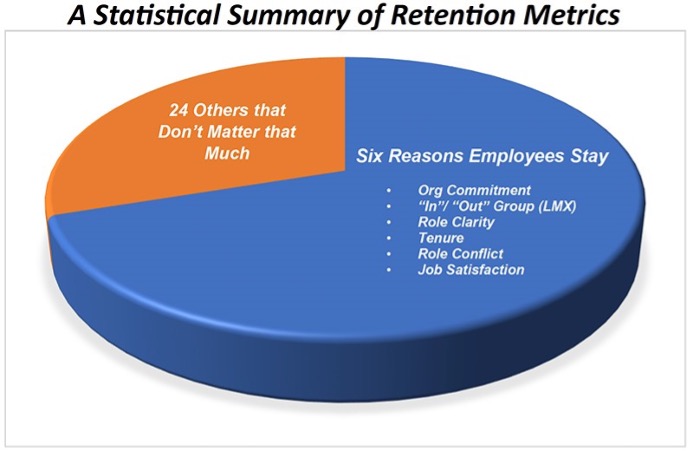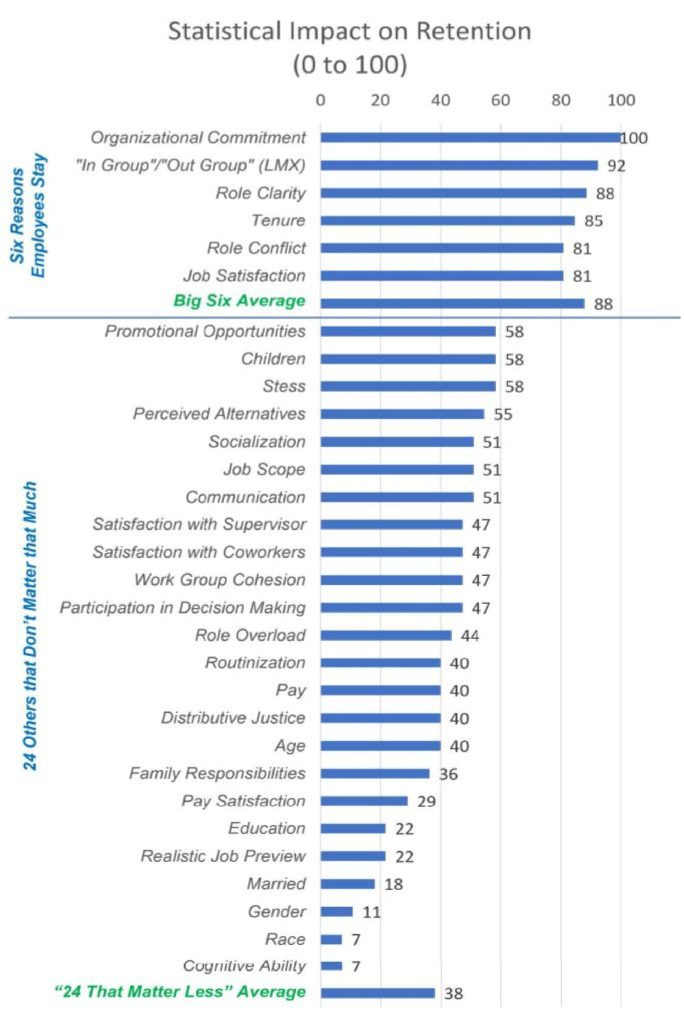6 Reasons Employees Stay
(And 24 Others That Don’t Matter That Much)
S. Richard Park, Ph.D.
Imagine yourself at lunch with five of your colleagues. You ask them this question:
“Why do people stay with their companies?”
Mayhem ensues. “Pay.” “Manager.” “Team cohesion.” “Fairness.” “Culture.” “The work.” “Feedback.” “PTO.” “Jobs available.” And on and on…
Why do your colleagues offer so many different answers? Because most employees form their opinions on very different professional experiences. Or they have different preferences/values. Or they each read different articles that 1) are positioned as “research” and 2) sound compelling. Or they heard it from a credible colleague who positions an opinion as fact. On and on again.
You’ll find this article very different. It’s a practical, easy-to-understand summary of the scientific evidence related to retention. Carefully defined, precisely measured factors that hold up to rigorous quality standards time, after time, after time. If it’s published in a professional journal (like the statistics in this article are), you can rest assured that it has been scrutinized and approved by many independent experts to get there.
Here’s one example that captures how scientific evidence might be produced:
- Group 1– 70 high-tenured employees at various companies.
- Group 2 – 70 employees who left the same companies.
- Both groups have similar demographics, similar jobs, similar employment markets, etc.
- The Question – Are wages for Group 1 statistically different than wages for Group 2?
And now the scrutinized metrics…

And the details…

Thoughts on the Statistics Above
- Pay doesn’t matter that much – Increasing compensation is the first thing that most managers do to retain their employees. The reality – “pay” and “satisfaction with pay” don’t matter that much from a retention perspective. They rank 20th/24th out of 30…bottom third or lower. Compensation increases only force other companies to pay a little more for your employee…decimal dust in the context of creating a competitive advantage for your business.
- Satisfaction with Supervisors” doesn’t matter that much – “People don’t leave companies, they leave managers” is a commonly used phrase in employee retention discussions. While managers do impact important retention variables like “Role Clarity” and “Role Conflict”, “Satisfaction with Supervisor” doesn’t matter that much.
- Not all turnover is “bad” – One theory of leadership called “Leader/Member Exchange” suggests that managers place their employees in one of two categories – “In Group” employees have a higher quality relationship with their manager than do those in the “Out Group”. (See “In Group”/”Out Group” (LMX) in the charts above.) Leaders usually place their employees in one of these two groups based (at least partially) on employee performance. This produces proportionally more turnover in the lower-performing “Out Group” – also known as “good turnover”.
- Isn’t “Tenure” obvious? – It may sound that way, but it’s actually quite useful from a practical perspective. If you’re going to spend time and resources improving retention, focus more on newer employees. Your longer-term employees aren’t likely to go anywhere else.
Anything Else?
We are committed to publishing articles that are brief and understandable. If we missed something that’s important to you or you want more detail contact us via our website or email us directly!
Our Content Library Check out our library of exclusive articles, videos, and books on our “Learn” page.
Source and Method
Allen, D.G., Bryant, P.C., & Vardaman, J.M. – “Retaining Talent: Replacing
Misconceptions with Evidence Based Strategies, Academy of Management Perspectives, 48-64.
Allen et al. extracted and synthesized correlation coefficients from 14 scientific articles on employee retention. We transformed their correlation coefficients into z-scores. The z-scores we produced formed the foundation for the metrics in the two charts above.

Author Bio
S. Richard Park, Ph.D. partners with executive business leaders to create a competitive advantage through people. He has held specialized roles in assessment design and validation, workforce development, rewards, performance management, culture, and organizational effectiveness.
Rick’s passion for business strategy prompted him to transition into HR executive roles supporting CEOs and other executives with global responsibilities. He has worked in technology (Dell, Microsoft), manufacturing (Georgia-Pacific, KSB SE & Co. KGaA), and HR consulting (AON).
Today, Rick leads an HR consulting firm called Talent Alignment, LLC. He brings a practical approach to the firm’s clients by focusing on delivering a competitive advantage through people. Rick’s ability to speak to executive leaders in business terms is much appreciated by his partners and their clients.
Rick coauthored #1 best-selling book called “When Work Works”. His chapter “‘So What Do You Do?’ The Answer Your CEO Will Love!” explains how HR and business leaders can design work processes to engage employees in creating a competitive advantage for their organizations. His chapter and the book are available here.
Rick earned a Ph.D. in Industrial/Organizational Psychology to help prepare him for a career in HR, talent management, and OE.
His volunteer work involves coaching incarcerated individuals and groups. He enjoys playing guitar, cycling, announcing high school sports, and home projects. He and his wife, Lisa, enjoy traveling, exploring restaurants, and spending time with their two adult children, Lauren and Michael (and their dog, Dempsey).
Rick can be reached at [email protected] and www.talentalignment.net.